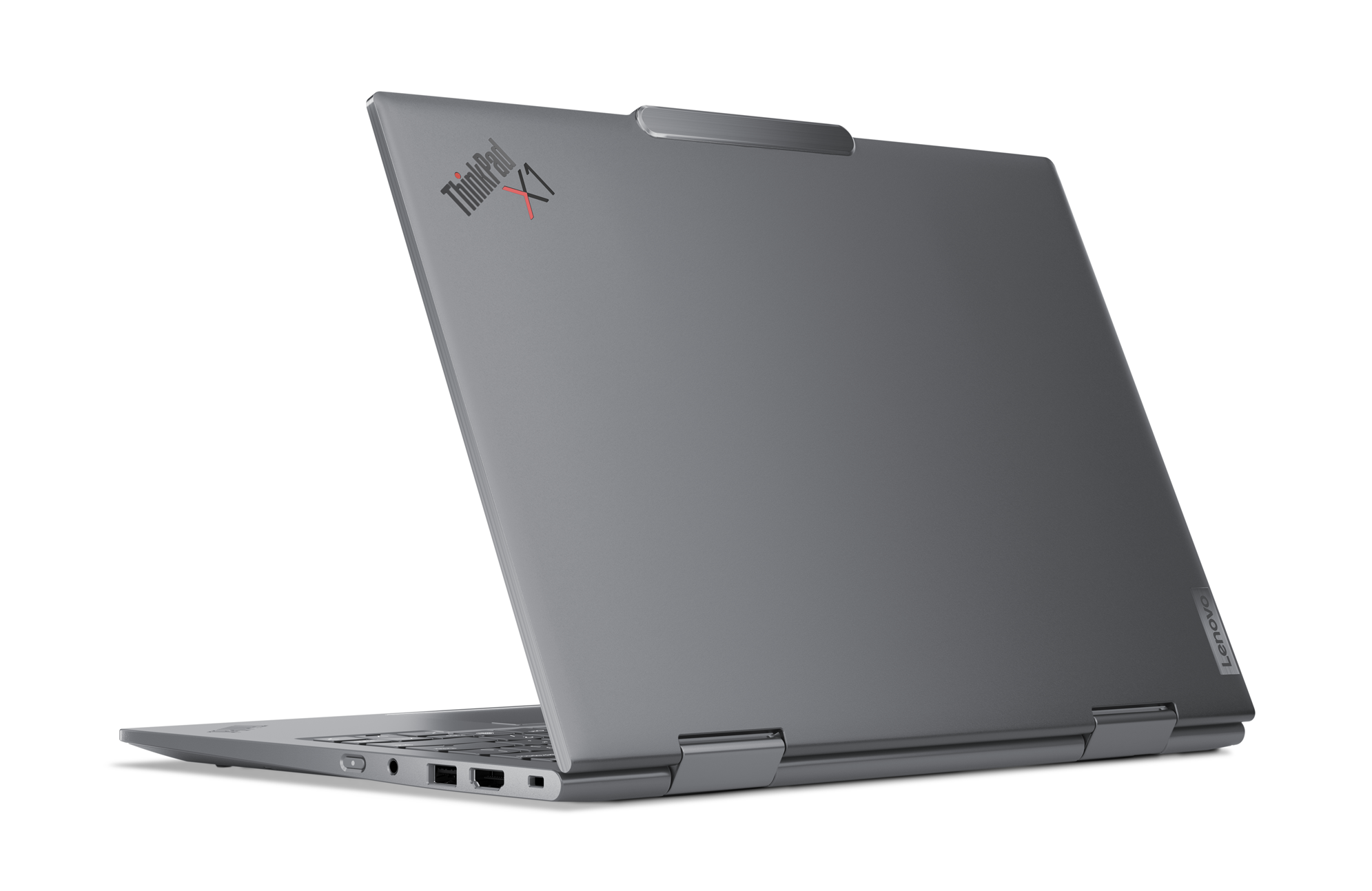Lenovo's ThinkPad X1 series—the traditional form factor X1 Carbon and the X1 Yoga 2-in-1—have long been top-notch flagship enterprise notebooks. The latest generation (Gen 9) continues that tradition with updates to its profile, speakers, and keyboard and a move to Intel's Core Ultra "Meteor Lake" platform.
It drops the Yoga name, as Lenovo now uses that for its high-end consumer notebooks. But like its sibling, the X1 Carbon Gen 12, the X1 2-in-1 is a lightweight machine featuring a hinge so you can fold it over to use as a tablet or stand it up to view videos or presentations. Still, like the X1 Carbon, I continue to be mystified by the subpar webcam on most configurations.
 (Credit: Lenovo)
(Credit: Lenovo)The basic design doesn't look all that different from last year's model (the X1 Yoga Gen 8). It's still a 14-inch notebook with an aluminum frame in a "Luna Grey" color that looks rather premium, a keyboard with a TrackPoint pointing device, and a touchpad.
But a lot of little things have changed from last year's version. There are smaller bezels, and the speakers move from the side of the keyboard to underneath it. As a result, the unit now measures 12.31 by 8.57 by 0.61 inches—compared with the previous 12.38 by 8.75 by 0.61 inches. The device I tested came in at 3.16 pounds, or a travel weight of 3.75 pounds with the included 65-watt charger, which is very light for a 2-in-1. It has a small bump for the communications bar that holds the webcam, a feature that is becoming more common.
 (Credit: Lenovo)
(Credit: Lenovo)The device I tested had a 1,920-by-1,200 IPS touch display with 400 nits that looked pretty good; other options include a 3,840-by-2,400 OLED display and a privacy guard version. Unlike the previous model, the X1 2-in-1 no longer has a docking port for an included pen, but the unit I tested came with an optional pen—bigger than the one included on the older model but still smaller than most of the full-size pens I've seen with tablets. The new pen attaches magnetically to the side of the laptop and delivers 4,096 levels of pressure sensitivity. I'm no artist, but it seemed to work very well.
The keyboard has been updated to include tactile bumps on some of the keys, making it easier for touch typists, swapping the control and function keys (though you can switch them back with an included application), and adding a separate fingerprint reader key in place of the old PrtSc one, rather than having the reader integrated into the power key. It does not have one of the Copilot keys that are coming to new Windows laptops.
 (Credit: Lenovo)
(Credit: Lenovo)As usual for ThinkPads, the keyboard was still very easy to type on. And like the X1 Carbon, it now has an interesting air intake design, with two front-firing speakers placed beneath it. I could feel a bit of vibration through the keyboard, but it wasn’t a real distraction. The speakers support Dolby Atmos and sound very good.
Like the new X1 Carbon, the X1 2-in-1 now has a larger 120mm glass touchpad with the familiar ThinkPad buttons on top. It’s a fine touchpad, though some competing models are larger. Double-tapping the familiar TrackPoint pointing stick in the middle of the keyboard brings up a Quick Menu that controls settings for the microphone, choosing your output device, and using your voice to type into a text box. It's interesting, but I can't say I used it much.
For ports, the left side has a USB-A port and two USB-C/Thunderbolt 4 ports (usable for charging), while the right side adds a Kensington lock, an HDMI port, another USB-A port, a 3.5mm audio jack, and the power button. It's great to see the full complement of ports, even if I would love to see USB-C ports on both sides. (For internal design reasons, I almost never see laptops with full-size HDMI and USB-A ports with USB-C on both sides.)
 (Credit: Lenovo)
(Credit: Lenovo)And then there's the webcam. The version I tested came with a 1080p FHD webcam with IR support, and images from it seemed a little fuzzy, a complaint I've had on most ThinkPads for a long time now. Models with the OLED display seem to come with an 8MP camera that should be better, but in an era where Zoom and Teams calls are a part of daily business life, I just don't understand why the base models would have poor cameras. But I do like that it has a physical privacy shutter.
For video enhancements, the X1 includes Windows Studio Effects, which offers basic controls such as background blur (either standard or a more pronounced Portrait mode), eye tracking, and framing. For more effects, you can use the separate Lenovo View application, which gives you more granular controls over color and brightness and a "low-light enhancer." Note that Lenovo View only works when the laptop is plugged in. The stereo speakers were fine, although I could feel some vibration through them when playing music.
Like all ThinkPads, the device comes with Lenovo Commercial Vantage, which allows for updates and offers some controls for the display and microphone as well as an optional Wi-Fi scanning service.
For performance, the model I tested came with an Intel Core Ultra 7 155U processor. This is a 15-watt processor with two performance cores (each of which can do multithreading), eight efficient cores, and two low-power efficient cores, for a total of 12 cores and 14 threads. The performance cores have a base frequency of 1.7GHz, with a maximum turbo speed of 4.8GHz. It has Intel Graphics with 4 Xe cores at a maximum of 1.95GHz. The processor is vPro capable.
Note this has fewer cores and less cache than the Core Ultra 7 155 H I tested on the X1 Carbon Gen 12 and the Dell XPS 14, and the 155U has a lower level of graphics than the Intel Arc Graphics with 8 Xe cores in the 155H. But both versions now offer vPro support.
Not surprisingly then, performance lagged the X1 Carbon Gen 12 and Dell XPS machines I tested, particularly in graphics performance. But it did significantly better on these metrics than the X1 Yoga Gen 8 based on the 13th Generation Core (Raptor Lake) or similar machines, so in that respect, it’s a big upgrade.
On my toughest tests, it transcoded a large video in Handbrake in 1 hour and 36 minutes, an improvement compared with 1:46 on the X1 Yoga Gen 8, but not nearly as fast as the 1:16 on the X1 Carbon Gen 12. Similarly, it ran a portfolio simulation in MATLAB in a little over 34 minutes, not as good as the 30 minutes on the X1 Carbon Gen 12 but better than the 37 minutes on the X1 Yoga Gen 8.
As with all the Meteor Lake systems I’ve tested, though, Excel performance lagged. It took 47 minutes to run a large Excel data table model, just a hair slower than the 46 minutes on the X1 Carbon Gen 12 and nowhere near as good as the 35 minutes it took the X1 Yoga Gen 8.
On AI tests, scores were similar to the other Meteor Lake systems with integrated graphics I’ve tested, and the smaller GPU didn’t seem to make much difference here. Machines with discrete graphics still seem to do much better, and in general, like most Meteor Lake machines, it’s not ideal for running AI models.
Battery life was outstanding. On PCMark 10's Modern Office battery test, I got 17 hours and 13 minutes at 100 nits, and 18 hours and 29 minutes at 40 nits, the best I've seen on a laptop. It has a 57 watt-hour battery that Lenovo says charges to 80% in one hour.
As I write this, on Lenovo’s website, a model similar to what I tested with a Core Ultra 5 125U processor, Windows Home, 16GB of RAM, 512GB SSD, 1,920-by-1, 200 IPS display, 1080p webcam, and a pen is available for $1,720.95. Not cheap, but not surprisingly expensive.
A model with a Core Ultra 7 155U processor, Windows 11 Pro, 16GB RAM, 512GB SSD, and the 2.8K OLED display (which is supposed to come with a 2160P UHD RGB +IR camera) and a slim pen came out to $2.065.20.
All in all, the ThinkPad X1 2-in1 Gen 9 is an excellent laptop, with a solid design, very good performance, and excellent battery life, along with the flexibility of the 2-in-1 design. I wish the webcam was better on units with standard displays, and would strongly recommend the OLED upgrade, but overall it’s a terrific system.


